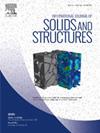Theoretical solution for 3D transient thermal–hydraulic–mechanical coupled axisymmetric problem and its application to casing–cement–formation system
IF 3.4
3区 工程技术
Q1 MECHANICS
International Journal of Solids and Structures
Pub Date : 2024-12-15
DOI:10.1016/j.ijsolstr.2024.113197
引用次数: 0
Abstract
In geomechanics and geoscience, the study of coupled processes is of paramount importance. This paper presents a theoretical solution, grounded in Biot’s theory, for the 3D transient thermal–hydraulic–mechanical (THM) coupled axisymmetric problem. Mathematical techniques such as the Laplace transform, Fourier expansion and the stress function method are employed to derive the THM solution. The Laplace transform is employed to manage time-dependent terms in transient equations, Fourier expansion is used to meet boundary conditions and stress functions establish connections between the stress field, seepage field, and temperature field. The validity of the THM solution is subsequently confirmed, demonstrating its accuracy. The theoretical solution is then applied to a casing–cement–formation system, a crucial structure frequently encountered in the oil industry. Given that the casing is generally considered impermeable, particular focus is placed on the boundary conditions at the casing–cement interface. A modeling of casing–cement–formation system is then conducted to show the THM coupling effect due to the temperature–pressure load. Furthermore, contour plots are employed to analyze the response of the system to linear loads.
求助全文
约1分钟内获得全文
求助全文
来源期刊
CiteScore
6.70
自引率
8.30%
发文量
405
审稿时长
70 days
期刊介绍:
The International Journal of Solids and Structures has as its objective the publication and dissemination of original research in Mechanics of Solids and Structures as a field of Applied Science and Engineering. It fosters thus the exchange of ideas among workers in different parts of the world and also among workers who emphasize different aspects of the foundations and applications of the field.
Standing as it does at the cross-roads of Materials Science, Life Sciences, Mathematics, Physics and Engineering Design, the Mechanics of Solids and Structures is experiencing considerable growth as a result of recent technological advances. The Journal, by providing an international medium of communication, is encouraging this growth and is encompassing all aspects of the field from the more classical problems of structural analysis to mechanics of solids continually interacting with other media and including fracture, flow, wave propagation, heat transfer, thermal effects in solids, optimum design methods, model analysis, structural topology and numerical techniques. Interest extends to both inorganic and organic solids and structures.

 求助内容:
求助内容: 应助结果提醒方式:
应助结果提醒方式:


